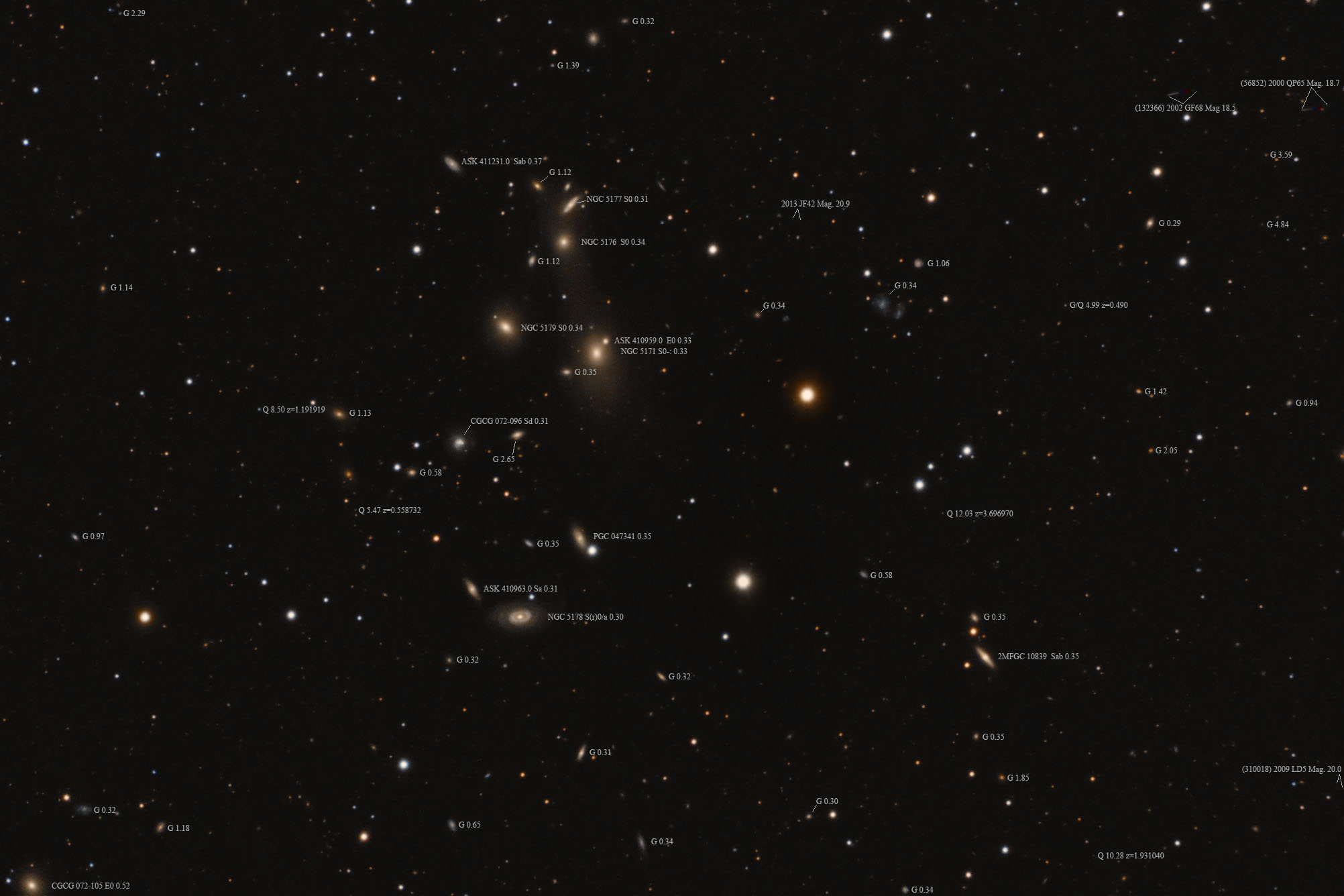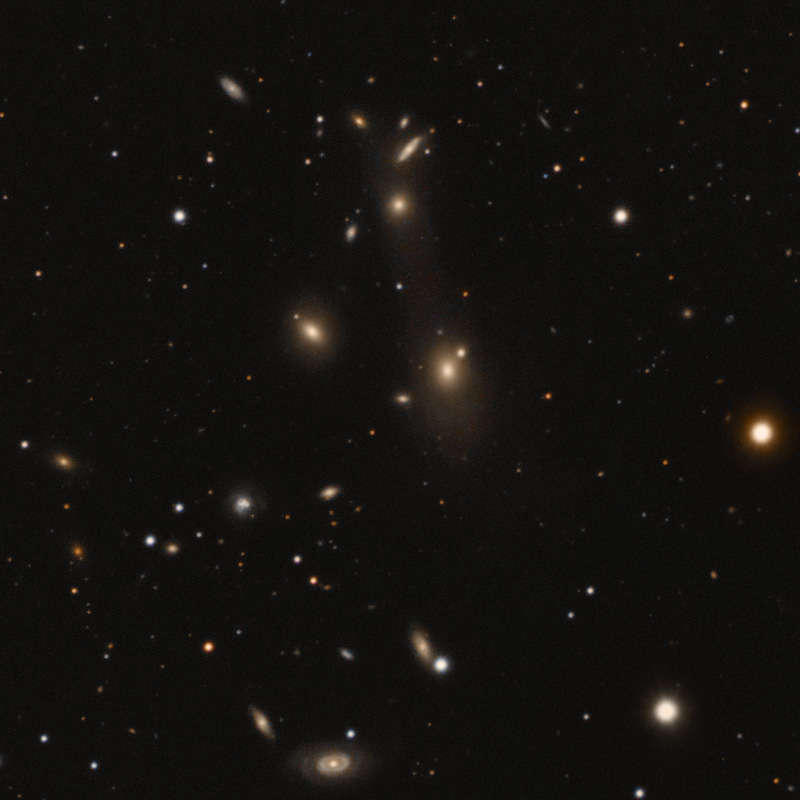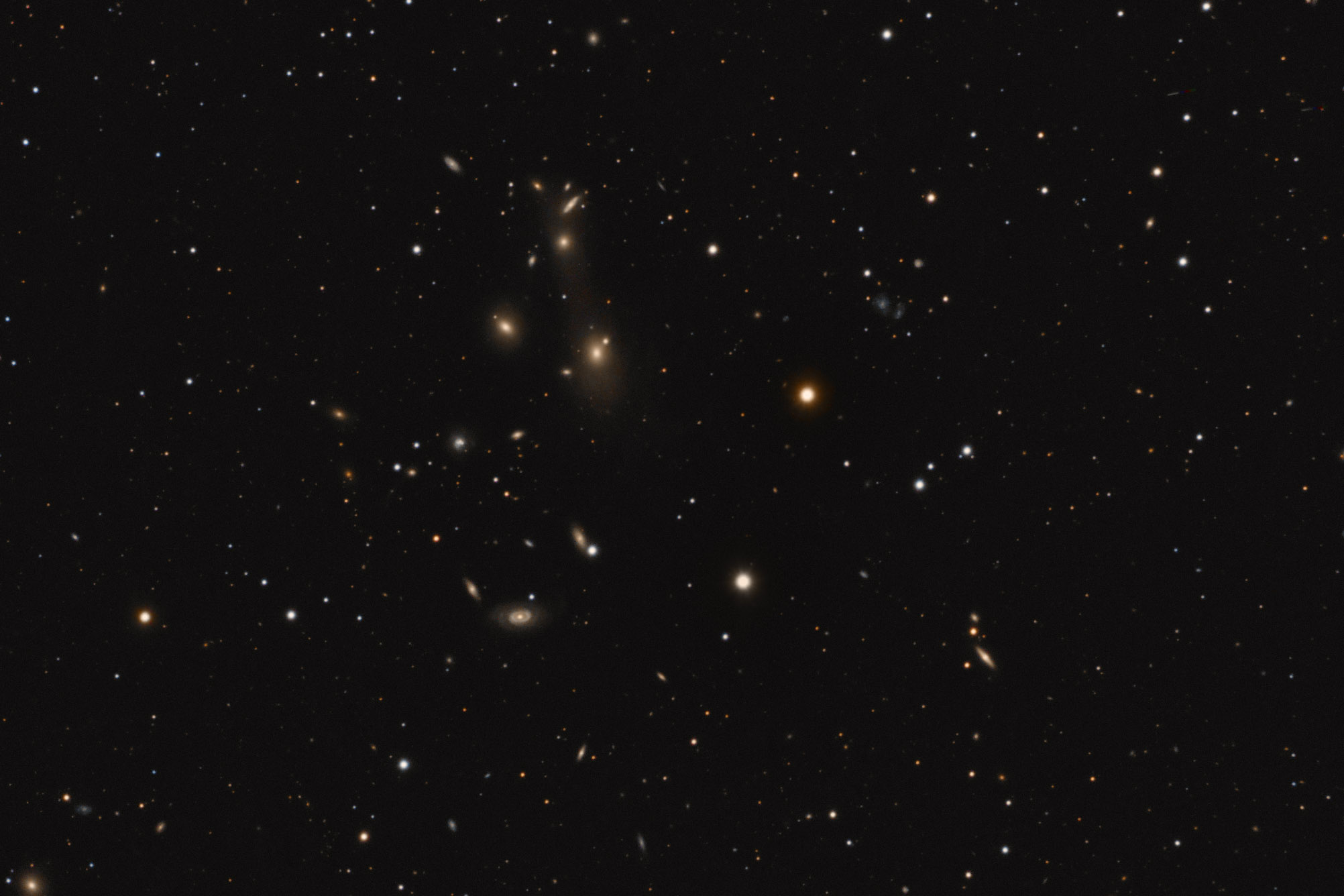| Description | Images |
Object name: NGC5171Designation(s): NGC5171, NGC5176, NGC5177, NGC5178, NGC5179, NGC 5171 is the brightest member of the NGC 5171 group of galaxies located in northeast Virgo about 330 million light-years distant. It is a subgroup of the very large galaxy cluster ZwCl 1327+1145 which is some 117 minutes of arc across (my field is only 33.4 minutes of arc across) and contains 449 members. It, in turn, is comprised of two subgroups, one of which is also about 320 million light-years distant though I found no size or galaxy count for it. The group is defined as open which means there is no central condensation but there are local ones such as the NGC 5171 group. Related Designation(s):2MASS J13292156+1144063, 2MASS J13292427+1147494, 2MASS J13292497+1146531, 2MASS J13292932+1137293, 2MASS J13293089+1144451, 2MASX J13292154+1144065, 2MASX J13292426+1147495, 2MASX J13292494+1146535, 2MASX J13292930+1137295, 2MASX J13293087+1144445, 2XMM J132921.5+114408, 2XMM J132924.2+114748, 2XMM J132929.2+113730, 2XMM J132930.9+114446, 2XMMp J132921.5+114407, 2XMMp J132924.1+114749, 2XMMp J132929.3+113729, 2XMMp J132930.9+114446, AGC 230366, ASK 410964.0, ASK 410973.0, ASK 411211.0, ASK 411213.0, CGCG 072-089, CGCG 072-090, CGCG 072-091, CGCG 072-093, CGCG 072-094, CGCG 1326.9+1200, CGCG 1326.9+1203, CGCG 1326.9+1204, CGCG 1327.0+1153, CGCG 1327.0+1201, CXO J132921.6+114407, CXO J132924.2+114748, CXO J132930.9+114445, ECO 04114, ECO 04115, ECO 04116, ECO 04118, ECO 04121, GALEXASC J132921.65+114403.3 , GALEXASC J132924.30+114749.4 , GALEXASC J132929.24+113729.1 , GALEXASC J132930.84+114445.2 , HDCE 0798 NED004, HDCE 0798 NED005, HDCE 0798 NED007, HDCE 0798 NED008, HOLM 521A, HOLM 521B, HOLM 522A, IRAS F13269+1202, LDCE 0978 NED004, LDCE 0978 NED005, LDCE 0978 NED007, LDCE 0978 NED008, MAPS-NGP O_498_0901158, MAPS-NGP O_498_0901429, MAPS-NGP O_498_0901497, MAPS-NGP O_498_0901899, MAPS-NGP O_498_0985539, MCG +02-34-019, MCG +02-34-020, MCG +02-34-021, MCG +02-34-022, MCG +02-34-023, MRK 1349, NGC 5171, NGC 5176, NGC 5177, NGC 5178, NGC 5179, NGC5171, NGC5176, NGC5177, NGC5178, NGC5179, NPM1G +12.0359, NPM1G +12.0361, NRGb 247.023, NRGb 247.024x, NRGb 247.026, NRGb 247.028, NRGb 247.032, NRGb 247.033, NSA 070626, NSA 070634, NSA 070696, NSA 070697, NSA 143529, NVSS J132929+113728, PGC 047337, PGC 047338, PGC 047339, PGC 047358, PGC 047363, PTF10fps HOST, SAFIRES J132924.30+114749.8, SAFIRES J132929.64+113729.7, SDSS J132921.56+114406.4, SDSS J132924.25+114749.3, SDSS J132924.26+114749.3, SDSS J132924.95+114653.3, SDSS J132924.96+114653.3, SDSS J132929.30+113729.1, SDSS J132929.31+113729.2, SDSS J132930.88+114444.9, SDSS J132930.88+114445.0, SDSS J132930.89+114445.1, SSTSL2 J132924.25+114749.1, UGC 08476, UGC 08478, USGC U537 NED04, USGC U537 NED05, USGC U537 NED07, USGC U537 NED08, USGC U537 NED09, UZC J132921.6+114406, UZC J132924.3+114751, UZC J132925.0+114653, UZC J132929.3+113729, UZC J132930.9+114445, UZC-CG 193 NED01, UZC-CG 193 NED02, UZC-CG 193 NED03, UZC-CG 193 NED04, WBL 447-004, WBL 447-005, WBL 447-006, WBL 447-007, WBL 447-008, [DZ2015] 600-01, [DZ2015] 600-03, [TTL2012] 019786, [TTL2012] 019794, [TTL2012] 037194, [TTL2012] 037195, | Permanent link: https://images.mantrapskies.com/catalog/NGC/NGC5171-NGC5176-NGC5177-NGC5178-NGC5179/NGC5171L4X10RGB2X10ID.JPG |


